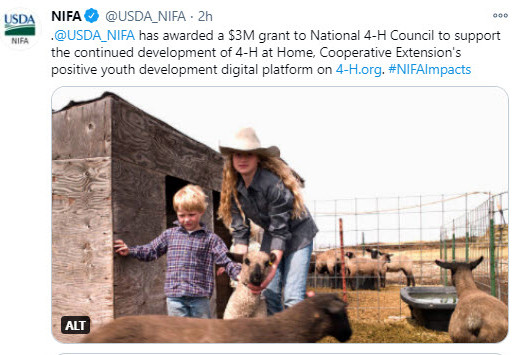
Upcoming NIFA Events
Stay informed with NIFA programs and activities by visiting the online event calendar. Here are a few upcoming webinar topics in January. Learn more by clicking on the program topic.
January 13, 2021
January 14, 2021
January 21, 2022
|

Webinars
New Beginning for Tribal Students
New Beginning for Tribal Students webinar January 13, from 1 to 2:30 p.m. Join in the Zoom meeting online.
FY2021 Gus Schumacher Nutrition Incentive Program (GusNIP)
NIFA will host a webinar for interested applicants to the FY2021 Gus Schumacher Nutrition Incentive Program. This webinar will provide an overview of the program’s grant types and project types, cost sharing or matching requirements, relevant SNAP regulations, and GusNIP core metrics. Please register in advance for this webinar online. You will receive a confirmation email containing information about joining the webinar after registering.
|

NIFA Career Opportunities
We are hiring! Remember to check out NIFA's Career Opportunities webpage, where there is a direct link to all open positions. You can also explore NIFA jobs at the USAjobs.gov website. Current openings in Kansas City, Missouri:
Deputy Director, (ES 00)
Closing Date: 1/06/2021
|

Robots in the Air and on the Water Could Improve Shellfish Farming
Aquaculture is the world’s fastest-growing animal-protein production sector, and the use of robots in many industries is growing quickly. At North Carolina State University, researchers are finding ways to build on these trends to increase marine aquaculture yields, ensure food safety and decrease the pressure to harvest wild seafood. It’s a step that could help the state on its way to a proposed goal of growing shellfish farming into a $100-million-a-year industry by 2030. The researchers plan to use small fleets of unmanned vehicles on the water and in the air to improve oyster production near the North Carolina coastline. The goal is to get the vehicles to work with each other to monitor water quality in areas that are difficult and dangerous for people to access. The four-year project was funded this fall by a $1 million grant from USDA’s National Institute of Food and Agriculture through the multiagency National Robotics Initiative 2.0. For more information, read the North Carolina State University article.
Sierra Young, left, and doctoral student Hemanth Narayan Dakshinamurthy are working to integrate unmanned surface and aerial vehicles to improve farming of oysters and other shellfish. Photo courtesy of Marc Hall.
|

University of Missouri Extension to Expand Mental Health Resources in Rural Areas
Missouri’s rural counties lack mental health services despite growing financial stress and suicide rates. All of Missouri’s 99 rural counties face a shortage of mental health professionals; 57 of them have none. University of Missouri Extension hopes to change that through a multistate project to help farmers, ranchers and farm families find affordable help close to home. MU is part of a $28.7 million, three-year grant from USDA’s National Institute of Food and Agriculture through the Farm and Ranch Stress Assistance Network (FRSAN). FRSAN supports projects that provide stress assistance and suicide prevention services for farmers, ranchers and others in agricultural occupations, says MU Extension health and safety specialist Karen Funkenbusch, who is MU’s principal investigator for the grant. For more information, read the MU article.
Rural Missouri, photo courtesy of Getty Images.
|

2021 National Nanotechnology Initiative Strategic Planning Stakeholder Workshop
Over the past 20 years, the National Nanotechnology Initiative (NNI) has supported nanotechnology discovery, development, and deployment that exists today. Nanoscience will advance a wide range of technologies and creating solutions to many future challenges. Conversations at the 2021 NNI Strategic Planning Stakeholder Workshop (January 11-13) will identify effective mechanisms to advance research and development, strategies for communication, and priority topics to shape future directions. View a detailed agenda or register online for this workshop.
Abstract conception of nanotechnology, courtesy of Getty Images.
|
NIFA Invests $8.5 Million in Research in Animal Nutrition, Growth, and Lactation
NIFA recently announced 23 Animal Nutrition, Growth, and Lactation awards that will lead to better management strategies for animal production systems, enhance production efficiency, and further develop high-quality animal products for human use. These advances will come from new foundational knowledge into the cellular, molecular, genomic and whole animal management strategies brought about by these projects. Rural prosperity brought about through greater farm profitability and increased exports are two of the ultimate goals of the federal investment. These grants are part of NIFA’s Agriculture and Food Research Initiative.
NIFA Invests $6.4 Million in Sustainable Agroecosystems: Functions, Processes and Management
NIFA recently awarded 16 Sustainable Agroecosytems grants that will improve the sustainable management of agro-ecosystems (agricultural, forest and range) while maintaining or improving the supporting natural resources and ecosystem services. The funded research will improve our understanding of the interactions among physical, chemical, and biological processes that determine the health and quality of soil, water and air resources, and how these respond to natural and human based changes and management. Other research will provide science-based information that integrates the complex interactions between natural processes and management practices that is needed to make decisions to support agricultural production, including bioenergy and biobased product feedstocks, maintain or improve ecosystem services and our natural resources. These grants are a part of NIFA’s Agriculture and Food Research Initiative.
NIFA Invests $4.3 million in Tactical Sciences Coordination Network to Safeguard Plant and Animal Health
NIFA recently announced a coordination network award that will help protect the integrity, reliability, and sustainability of the U.S. food and agriculture system from an array of known and potential threats including pests and diseases that impact plants and animals. The Tactical Sciences Coordination Network will bring together public and private sector entities at the regional and national level, to jointly plan and implement efforts to narrow existing gaps in food and agricultural defenses, increase national capacity to prevent, and rapidly detect and respond to biological threats to the U.S. food supply.

Following passage of the FY2021 Omnibus and COVID Bill, NIFA staff are working to update current RFAs to reflect any significant policy changes. Any changes made to RFAs will be highlighted on the web page for that RFA and featured in NIFA Update. Final award numbers and amounts will reflect available funding at the time of award.
Also, we are pleased to announce that some of the RFAs scheduled for publication in February may be published later this month. Please continue to follow the RFA Calendar and Grants.gov for the most recent opportunities. Sign up to have Funding Opportunities emailed directly to you.
What's new?, graphic courtesy of Getty Images.
|
Methyl Bromide Transition Program (MBT)
The MBT program addresses the immediate needs and the costs of transition that have resulted from the phase-out of the methyl bromide pesticide. Methyl bromide has been a pest- and disease-control tactic critical to pest management systems for decades for soilborne and postharvest pests. For more information, read the full MBT funding opportunity.
Food and Agricultural Sciences National Needs Graduate and Postgraduate Fellowship (NNF) Grants Program
The NNF grants program supports: training students for master's and doctoral degrees in food, agricultural and natural resource sciences; and special international study or thesis/dissertation research travel allowances for eligible USDA NNF beneficiaries. Applicants provide clarity about the philosophy of their graduate training and relevance to USDA mission sciences, NIFA priorities and national science education policies and statistics. For more information, read the full NNF funding opportunity.
Agriculture Risk Management Education Partnerships Competitive Grants Program (ARME)
The ARME program helps to educate agricultural producers about the full range of risk management activities. These activities include: futures, options, agricultural trade options, crop insurance, cash forward contracting, debt reduction, production diversification, marketing plans and tactics, farm resources risk reduction, and other appropriate risk management strategies. For more information, read the full ARME funding opportunity.
Gus Schumacher Nutrition Incentive Program (GusNIP) Formerly known as the Food Insecurity Nutrition Incentive Program (FINI)
The GusNIP program supports projects to increase the purchase of fruits and vegetables among low-income consumers participating in the Supplemental Nutrition Assistance Program by providing incentives at the point of purchase. For more information, read the full GusNIP funding opportunity.
Community Food Projects Competitive Grants Program (CFPCGP)
The CFPCGP program fights food insecurity through developing community food projects that help promote the self-sufficiency of low-income communities. CFP supports the development of projects with a one-time infusion of federal dollars to make projects self-sustaining. For more information, read the full CFP funding opportunity.
Beginning Farmer and Rancher Development Program (BFRDP)
The BFRDP program provides mandatory funds to support the education, training, outreach and mentoring programs to enhance the sustainability of the next generation of U. S. farmers and ranchers. For more information, read the BFRDP funding opportunity.
Crop Protection and Pest Management (CPPM)
The CPPM program addresses high priority issues related to pests and their management using integrated pest management approaches at the state, regional, and national levels. CPPM supports projects that ensure food security and respond effectively to other major societal pest management challenges. For more information, read the CPPM funding opportunity.
Emergency Citrus Disease Research and Extension (ECDRE) Program Pre-Application
The ECDRE program addresses priorities identified by the Citrus Disease Sub-committee of the National Agricultural Research, Education, Extension and Economics Advisory Board through projects that integrate research and extension activities that use systems-based, trans-disciplinary approaches to provide solutions to U.S. citrus growers. For more information, read the ECDRE funding opportunity.
Youth Farm Safety Education and Certification Program (YFSEC)
The YFSEC program supports national efforts to deliver timely, pertinent, and appropriate farm safety education to youth seeking employment or already employed in agricultural production. For more information, read the YFSEC funding opportunity.

|